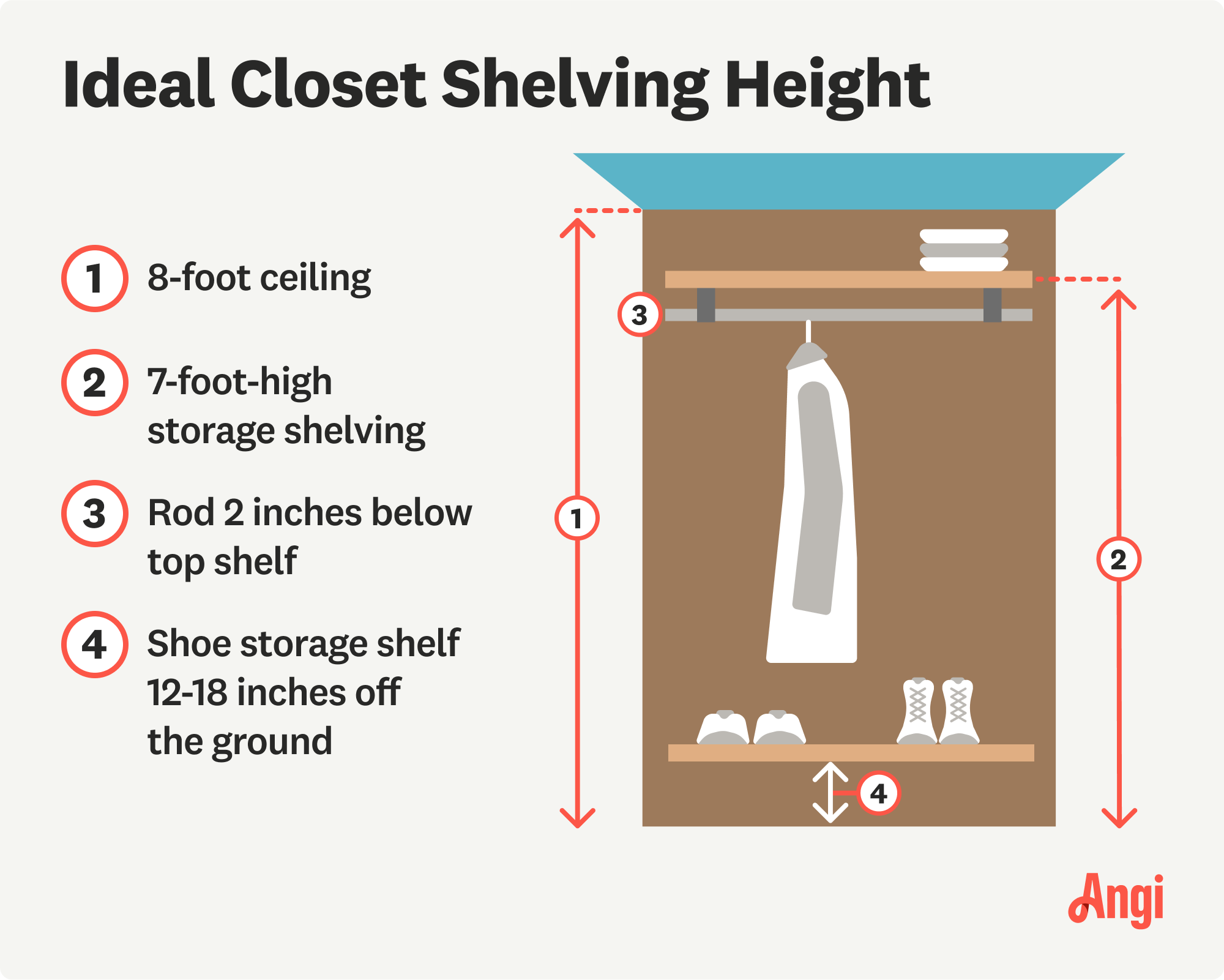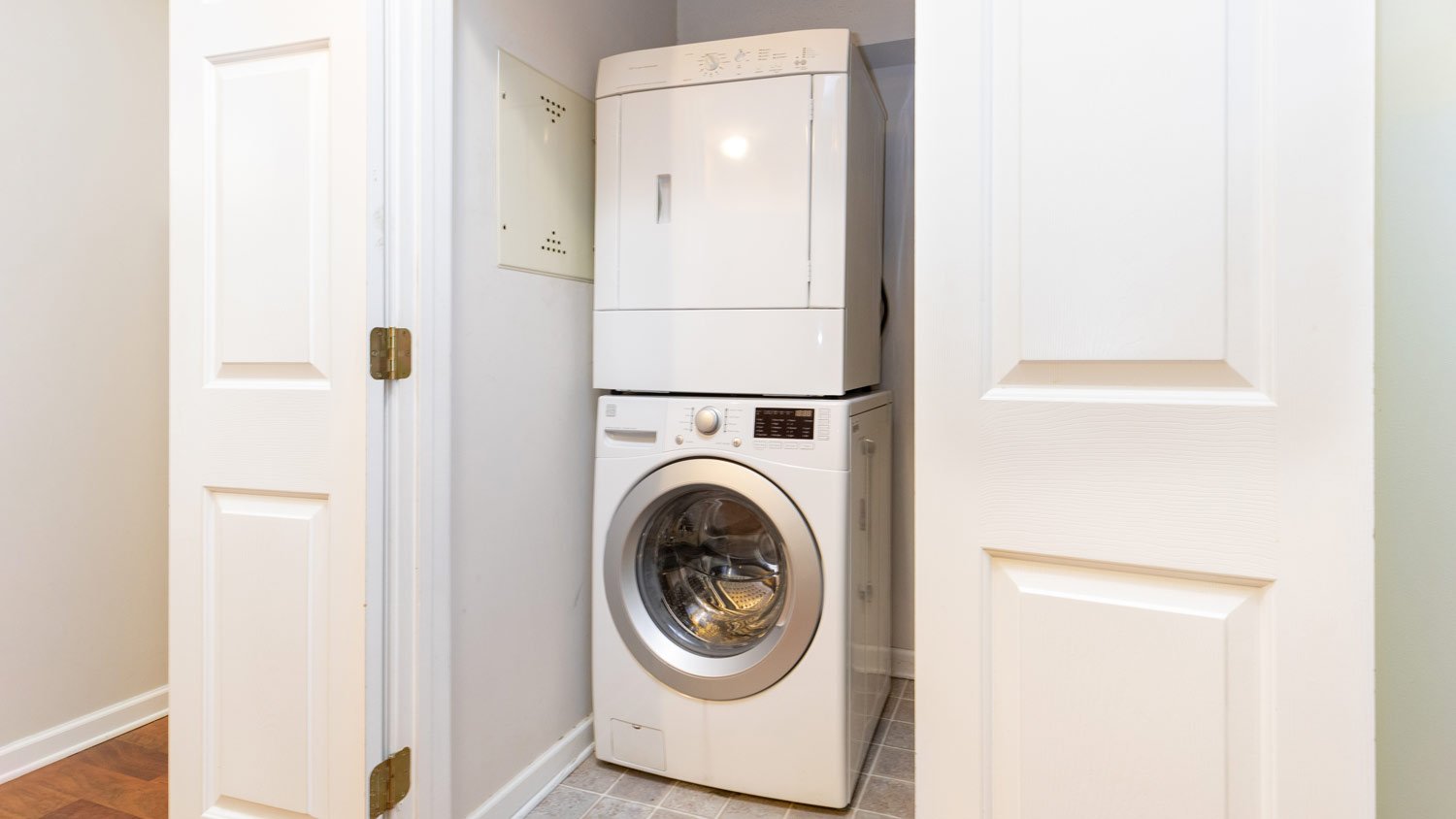
The cost of a closet remodel depends on the closet size, materials used, and the level of customization. Learn what else influences your closet remodel cost.
Getting your favorite coat shouldn't be a stretch


A well-organized closet makes it easy to access the clothes you love and to keep out-of-season or infrequently used items tucked away. Closet shelving at just the right height can help you grab what you need when you need it. The most common closet shelving height is about 84 inches off the ground, but the best height for you depends on what you're storing and who needs access to the closet.

Closet shelving isn't one-size-fits-all. While there's no standard closet shelving height to follow, there are some general guidelines that can help you determine the right height for your shelves and clothing rods.
For example, if your home has 8-foot ceilings and you're average height, a closet shelf that's 7 feet high is most likely perfect for items you don't use that often, such as out-of-season clothing or extra blankets.
For shoe storage, try not to go too low. A shelf that's about 12 or 18 inches high is usually perfect for shoes.
If you have multiple shelves in your closet, space them about 12 to 16 inches apart. Doing so will give you ample room to stack piles of sweaters or folded pants without feeling like you're squeezing in all your stuff.
While there isn't a standard height for shelving, it's a different story for closet rods. Generally, if you're going to build a closet with a single clothes rod, the rod should be 66 inches from the floor. At that height, the average person can easily reach clothing and longer garments, such as dresses or coats, won't drag on the floor.
If your closet will have two clothing rods, one on top of the other, your top rod should be 80 inches from the floor. The second, lower rod should be 40 inches above the floor. With a double rod system, you'll be able to hang up shorter items, such as shirts, skirts, and jackets.

The height of your closet's shelves and rods may vary based on the use of the closet or who will use it. When measuring for height, measure from the bottom of the shelf or rod, not the top.
If you are installing a shelf above a clothing rod, leave at least 2 inches between the top of the rod and the bottom of the shelf, so there is space to move hangers in and out.
| Type of Closet | Shelving Height | Rod Height |
|---|---|---|
| Coat Closet | Top shelf: 80 inches Bottom shelf: 12 inches | 66 inches |
| Walk-in Closet | Top shelf: 80 inches | 66 inches for single rod 80 and 40 inches for double rod |
| Kids' Closet | 36 inches | 36 inches |
| Accessible Closet | 54 inches | 54 inches |
| Storage Closet | Top shelf: 80 inches Bottom shelf: 12 inches Up to 16 inches between shelves | N/A |
A reach-in coat closet typically has one rod for hanging coats and jackets and a shelf or two for storing other outdoor accessories, such as winter boots or hats.
Stick with the standard single rod height of 66 inches for your coat closet. If you're installing shelving, the lowest shelf can be 12 inches high while the upper shelf, above the rod, can be between 68 and 80 inches high.
The world is really your oyster with a walk-in closet. You can install built-in shelves on one side of the closet and a rod on the other, or mix it up and have shelving next to a double clothing rod.
Follow the same general rules for rod and shelving heights in a walk-in. For example, if you have two clothing rods, have the top rod installed at 80 inches above the floor and the bottom one at 40 inches. The top shelf should also be at 80 inches.
Shelf and rod height in a child's closet depends on their age and size. For very young children, a clothing rod that's no higher than 40 inches from the ground is ideal. Your child will be able to reach their clothing with ease.
To allow room to grow, consider installing a double rod in your child's closet. When they are small, they can stick with using the lower rod. As they get taller, they'll be able to reach the upper rod and any higher shelves.
If you are building an ADA-accessible closet, the shelves and clothing rods should be lower to the floor. An ideal height is between 48 and 52 inches, with a maximum height of 54 inches.
A storage closet may skip the clothing rod entirely and simply contain shelving. In that case, think of the closet like a built-in bookcase with a door.
Installing the lowest shelf 12 inches from the floor will allow you to make use of the floor as a storage area without having to stoop too low to reach the lowest shelf. To ensure you don't need a ladder to get the items on the top shelf, make the uppermost shelf no more than 80 inches from the floor.
For intermediary shelves, give yourself at least 16 inches of height between each one.
While there are general recommendations for closet shelving and rod height, when it comes down to it, the height of the person who will use the closet the most matters. The cost of a custom closet can be worth it if you're taller or shorter than average and don't want to strain to reach your belongings.
The length of the garments you plan on storing in the closet also affects the height of the rods and even shelving. Big, bulky sweaters will need more storage space than thin T-shirts, for example. Longer coats and dresses need plenty of height so they don't bunch up on the floor and get wrinkled hems.
Your storage needs and how easily you need to access whatever you put in the closet can also influence the ideal height. For example, you don't need to keep infrequently used items within easy arms' reach or at eye-level.
Think about safety when installing closet shelving. If you're hanging rods or shelves in a child's closet, putting them at an easy-to-reach height means your child won't be tempted to climb on a chair or use the shelving as a ladder to get what they need.
If your closet shelves are too high or too low, working with a local professional closet maker can help you get the storage space of your dreams.
If pulling out your current closet set-up isn't in the cards or the cost of custom closet design isn't in your budget right now, you have some other options:
Install a temporary closet rod: You can purchase a second closet rod that hooks over the existing rod in your closet to lower the height of hanging items.
Use a step stool: If your shelves are too-high and hard-to-reach, a simple step stool can make your storage space more accessible. Just be careful not to put one in a kids' closet, to reduce the risk of them falling.
Put a bookcase in the closet: If space allows and your existing closet shelving is too high, consider placing a small bookcase inside the closet so that you can easily reach what you need.
From average costs to expert advice, get all the answers you need to get your job done.

The cost of a closet remodel depends on the closet size, materials used, and the level of customization. Learn what else influences your closet remodel cost.

Discover the cost to hire a professional closet organizer, including average prices, cost factors, and tips to help you budget and maximize your investment.

Discover the average custom closet cost, including price ranges and key factors, to help you budget and plan your project with confidence.

A well-crafted closet can instantly make your mornings more enjoyable. Learn how to design a closet that blends functionality with style.

A washer and dryer closet is a convenient laundry solution. We explore common washer and dryer closet dimensions so you can choose the right one for your home.

Although the average walk-in closet dimensions are about 7-by-10 feet, you can create a smaller or larger one based on what you have available.